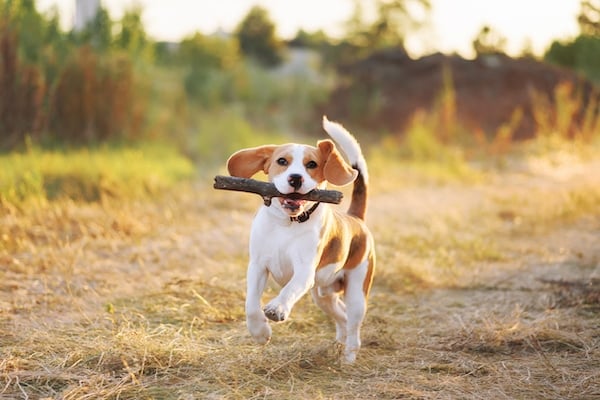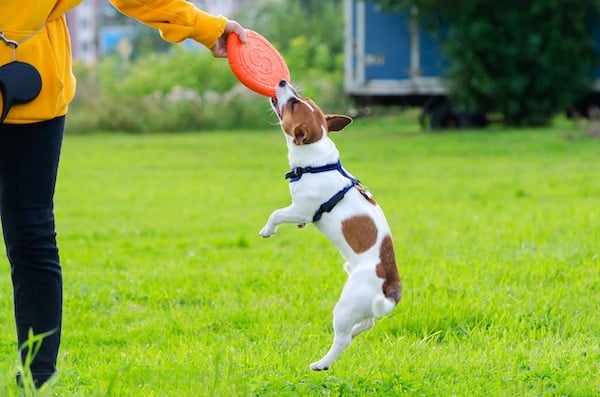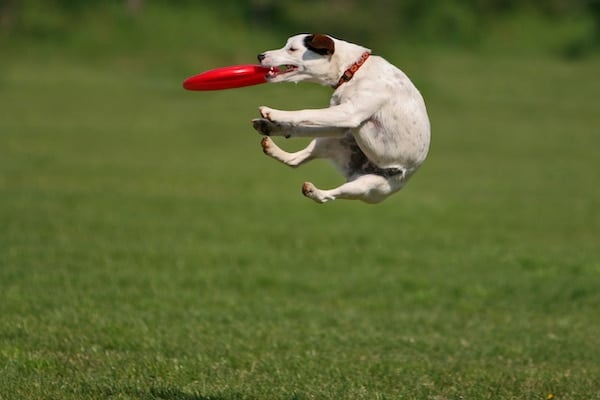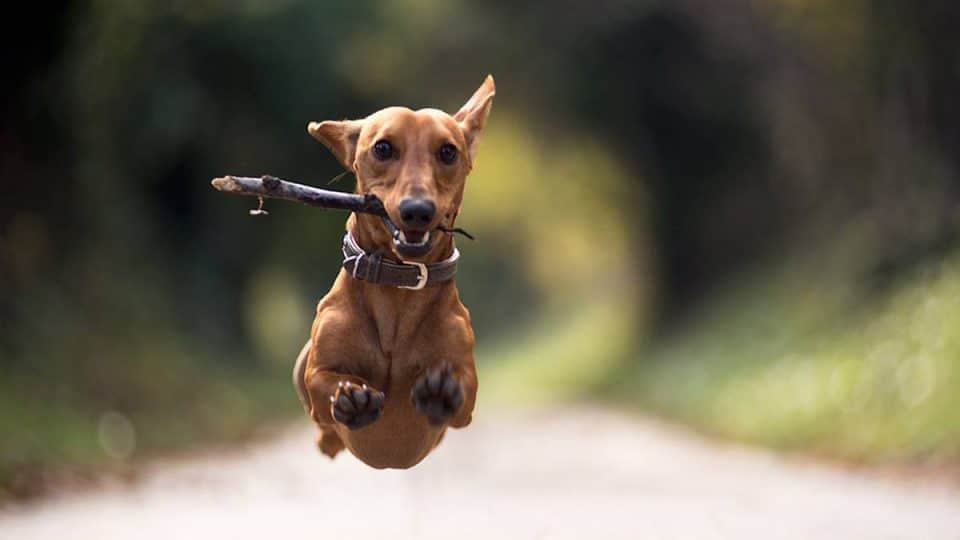- This post contains affiliate links. Read more here.
- Not a substitute for professional veterinary help.
Some dogs love to fetch a ball or frisbee until the cows come home. But can you have too much of a good thing?
Done properly, fetch can be a wonderful way to bond with your dog by helping them stay active. Done improperly, fetch can lead to unwanted complications, like joint issues and obsessive behavior. That’s why it’s important to play fetch the right way, with a warm-up, balls thrown at the proper angle, and plenty of breaks.
“We often say that everything is good in moderation, and that applies just as much to our dogs as it does to us,” summarizes Lynda Taylor, canine behaviorist and professional dog trainer with Depend on Dogs.
With her and other experts’ help, we consider best practices for safe fetch, what to watch for, and how to find engaging alternatives.
Why Do Dogs Like Fetch?
“The primary reason dogs love fetch is that it simulates the act of chasing prey,” says Jennifer Malawey, certified professional dog trainer. When a wolf brings food home to the pack, it’s the same root behavior that drives a Golden Retriever to fetch a tennis ball.
Additionally, Taylor says that some dogs may learn to love fetch if you reinforce the behavior, such as giving them a treat after they bring you their ball. “Playing fetch can also be self-reinforcing,” she says. In essence, some dogs just think it’s fun!

Tetiana Garkusha via iStock
Benefits of Fetch VS Risks of Unregulated Ball Chasing
Pro: easy exercise
Beyond satisfying your dog’s retrieving instinct, fetch can also give them plenty of exercise. Plus, you don’t have to do any running or jumping yourself. That can come in handy on days when you’re feeling tired but your dog still needs a workout.
Pro: enrichment and bonding
Beyond working their bodies, fetch can also work your dog mentally. Your dog’s sense of sight and smell are linked in their brain, so even blind dogs can fetch balls. Playing fetch can also function as a team game between you and your dog, improving the way you communicate and bond together.
Con: stress on joints and muscle tissues
That said, fetch isn’t always fun and games. “Repeatedly sprinting, leaping in the air, and changing direction can put a tremendous amount of stress on your dog’s joints,” says Davis. This could, in turn, contribute to conditions like arthritis or hip dysplasia, she adds. In fact, canine arthritis experts recommend that dogs with arthritis refrain from chasing balls altogether.
Experts believe that the most dangerous component of chasing a ball is braking—when your dog suddenly pitches their weight forward. What’s more, if your dog injures one of their legs, they could easily shift their weight to another leg without you noticing. And once your dog starts to overcompensate, their overworked tissues are more likely to take damage.
Con: encouraging compulsive behaviors
“The need to play fetch can also become a compulsive disorder,” Taylor says. Some dogs may become obsessed with fetch to the point where they don’t want to play anything else. They may even keep going when they’re exhausted or hurt. “This can lead to physical collapse, dehydration, and even heatstroke, in hot weather,” Taylor explains.

Таисья Корчак via iStock
What Is the Right Way To Play Fetch?
So, is all fetch bad for dogs? Not necessarily! “A dog could get injured playing fetch, in the same way you could be injured doing gymnastics or cycling,” says Malawey. “But you don’t stop doing the activities you love because they come with a risk: You just make them as safe as you can.”
To create a safe, enjoyable game of fetch for you and your dog, Davis and Malawey lay out the following pointers.
- Warm up your dog: Just like you warm up before starting an intense workout, give your dog time to build up to a more intense fetch session.
- Adjust your angle: Throw the ball or toy low to the ground to keep your dog from jumping and twisting. If you’re using an automatic ball thrower, try adjusting it to a lower angle.
- Level the playing field: Only play fetch on flat surfaces, so your dog won’t trip over holes in the ground or a bunched-up rug.
- Combine it with obedience: For added mental stimulation, try using fetch to reinforce other behaviors. For example, if you’re teaching your dog “down,” ask them to lie down before you throw the ball.
- Take breaks: Remember to take breaks throughout your session, especially if it’s hot, and have water on standby.
- Set a limit: Restrict the amount of time you play fetch every day to keep the game from becoming too repetitive. You can also play fetch at random times, without a set schedule, to keep it fresh and exciting.

cerae via iStock
Alternatives to Fetch
Of course, if you’re still concerned about straining your dog’s joints or want to broaden their horizons, there are plenty of other games you can try.
Our trainers recommend the following activities to provide mental and physical stimulation as fetch alternatives.
- Nosework: Hide treats in the grass or around the house for your dog to sniff out. You could also put them in a puzzle toy for an extra challenge.
- Tug of war: Grab a rope or a ring toy and challenge your dog to tug of war. Try experimenting with different toys to find the texture that your dog likes best.
- Flirt pole: Flirt poles are toys that look like a fishing rod with a toy at the end. Playing with one could satisfy your dog’s need to chase without the added joint strain.
- Obedience training: Break out the clicker and teach your dog some new tricks in an obedience session. You could use treats as a reward or play sessions for more exercise.
- Go for a walk: If all else fails, a good old-fashioned walk could provide the exercise your dog craves. For added stimulation, try taking them somewhere new to experience different sights and smells.
- Work on cues like stay, relax, and lay down: Training games offer a lot of mental enrichment, and these particular cues are smart ones to work on, since you can bring them back to your fetch game to help your dog relax between throws. Professional trainers can help you troubleshoot.





